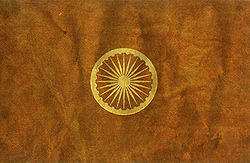Difference between revisions of "Maratha Confederacy (ETW Faction)"
(→Overview) |
|||
| Line 13: | Line 13: | ||
==Overview== | ==Overview== | ||
| − | Maratha has | + | Maratha has severe weaknesses--the inability to research Fire by Rank (and other equivalent squad firing technologies) and the complete lack of any formal light infantry. These deficiencies will haunt them in the late-game where both are important assets. The Maratha do, however, possess large amounts of high-quality melee infantry, elephants, and superior artillery. |
==Starting Position== | ==Starting Position== | ||
Revision as of 23:07, 30 July 2011
| Maratha Confederacy (ETW Faction) | |
|---|---|
 | |
| Name: | Maratha Confederacy |
| From Game: | Empire: Total War |
| Religion: | Hindu |
| Culture: | Indian |
| Playable: | |
The Maratha Confederacy is one of the 11 playable major factions in Empire: Total War's Grand Campaign.
Contents
Game Description
In the 18th century, the young Maratha Confederacy is aiming for expansion. They wish to reclaim India's lands from the Mughal rulers in the north. Since the Mughals are Muslims, the Maratha Hindus consider them foreigners. Therefore, the conflict is also a religious one - to an extent at least. While the Mughal Empire is large and contains many riches, the country's army is not big nor strong enough to counter major invasions. The Mughals have become used to their power and the Marathas have a good chance of success in the upcoming war.
However, the empire of Mysore which borders the Maratha Confederacy as well, which might become a thorn in the Marathas' side. Mysore's intentions aren't clear, and it is hard to surmise what goals they may have in mind. Furthermore, European powers such as Portugal and the United Provinces have already gotten involved in the Indian theater. For now, their only intentions are fiscal, but it is impossible to tell what they may end up doing. A war in their southern regions against Europeans with modern rifles and cannons is the last thing the Marathas need right now. For now, the peace should be kept - until the Mughals are dealt with, at least. Eventually, the Marathas will have to prove that their type of warfare can compete with that of the Europeans. But will armies consisting mostly of swordsman, a few riflemen and some elephants be able to handle Europe's modern armies?
Overview
Maratha has severe weaknesses--the inability to research Fire by Rank (and other equivalent squad firing technologies) and the complete lack of any formal light infantry. These deficiencies will haunt them in the late-game where both are important assets. The Maratha do, however, possess large amounts of high-quality melee infantry, elephants, and superior artillery.
Starting Position
Victory Conditions
Short Campaign
Capture and hold 15 regions by the end of the year 1750, including Gujarat, Hindustan, Hyderabad, Goa, Malwa, Bijapur, Berar, Carnatica, Mysore, and Ahmadnagar.
Long Campaign
Capture and hold 24 regions by the end of the year 1799, including Gujarat, Hindustan, Hyderabad, Goa, Malwa, Bijapur, Berar, Carnatica, Mysore, Ahmadnagar, Punjab, Orissa & Circars, Bengal, and Ceylon.
World Domination
Capture and hold 40 regions by the end of the year 1799, including the region Bijapur.
Basics at start
- Protectorates – None
- Allies – None
- Trade Partners – United Provinces, Mysore
- Enemies – Pirates, Mughal Empire
- Religion – Hinduism
- Government – Absolute Monarchy
- Ruler – Tarabai I (Queen)
- Population – 2,483,276
- Prosperity – Moderate
- Prestige – Feeble
- Treasury – 7500
- Technology - None
- Brahmin – Abhinash Yalamanchili (Bijapur)
- Eastern Scholar – Shrimant Pannu (Bijapur)
- Thugee – Gagan Raavi (Ahmadnagar)
- Generals - Rustam Akurdikar (Satara), Jainil Rawat (Ahmandnagar), Balkrishna Indukuri (Hyderabad)
- Admirals - None
India Theatre
Satara, Bijapur
- Starting Buildings – Barracks, Subadar’s Palace, Nautch Dancing School, Cannon Foundry, Settlement Fortifications
- Infrastructure - Basic Roads
- Population – 802,138
- Wealth – 3602
- Religion – Hinduism 85.0%, Islam 15.0%
- Starting Towns/Ports – Khed Wetlands (Rice Paddies), Kolhapur (School), Bijapur (Cotton Weaver’s Cottage), Vengurla (Trading Port)
- Later Villages/Ports – None
- Plantations – Yadgir Plantations (Small Cotton Plantation)
Arcot, Caranatica
- Starting Buildings – Military Governor’s Encampment, Settlement Fortifications
- Infrastructure – Basic Roads
- Population – 1,681,138
- Wealth – 4905
- Religion – Hinduism 90.0%, Islam 10.0%
- Starting Towns/Ports – Gudur Wetlands (Rice Paddies), Rajapalaiyam Mines (Open Gem Pit), Trichinopoly (Tavern), Cochin (Cotton Weaver’s Cottage), Calicut (Trading Port)
- Later Villages/Ports – Madras (Port), Pondicherry (Port)
- Plantations – Darahpuram Plantation (Small Tea Plantation), Periyar Plantation (Small Spice Plantation)
Units
The Marathas Confederacy does not boast outstanding armies of line infantry and grenadiers, like those of their European counterparts. Rather, especially in the beginning of the campaign, the faction relies more heavily on melee units, such as Hindu Swordsmen, to close the gap and fight the enemy.
However, being situated in India, generals have access to elephants instead of horses, which not only are sturdy and boast ranged weaponry, but also provide a morale effect against any potential adversaries (the downside being a larger target for enemy cannon).
Cavalry
Infantry
- Armed Populace
- Firelock Armed Populace
- Armed Peasantry
- Desert Warriors
- Tufangis
- Bargir Infantry
- Musketmen
- Hindu Musketeers
Special Units
The Marathas can train an unlimited number of formidable Sikh solders out of the regions of Punjab, Kashmir, and Hindustan. Sikh warriors have superior statistics compared to Hindu units and also have better morale. If the Marathas conquer the Persian regions, they can also train Afghan Hillmen, irregulars.

